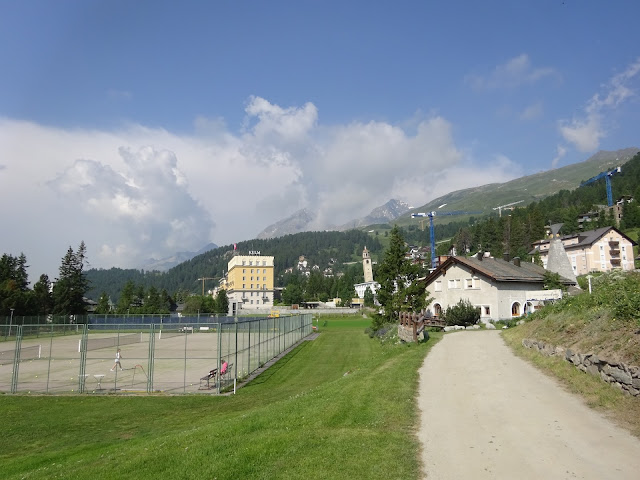In the distance you can see my destination: Fort L'Ecluse. That's a train bridge over the Rhone river. Behind the bridge you can see the fort. However, you need to look way above the fort to see a secondary fort. More about that later. This narrow gorge has been a strategic stronghold since medieval times.
If you were a traveler bringing goods or just passing through a toll was collected. An abbey was located on the site in 1184 and even back then the monks charged a toll.
I'm getting closer to the lower fort which isn't visible from here. But, can you see the upper fort in the top right? The upper fort was built between 1834-1848. Why? Back in 1815 the Austrians arrived and within three days the French surrendered. How did the Austrians manage to do that? They made their way up the backside of the mountain to where the upper fort is now located. From that position the Austrians proceeded to rain down a barrage of rocks.
Years later the French were given the place back in a treaty. To be sure it never happened again--they spent 14 years building the upper fort.
That speck of white under the telephone poles isn't a road but a mudslide. There's no road or trail leading to the upper fort.
This is the fort's entrance on the French side.
In medieval times this was a drawbridge.
This is the entrance to the fort if you were entering France from Switzerland (about 20 miles away).
Back in the day, if you're entering the fort you'd wait for the drawbridge to be lowered. Soldiers up above the bridge would be looking down upon you from these positions.
From 1940-1945 the Germans controlled the fort. Here's a photo of a German guard on duty.
Because of what happened in 1815 the French decided to build an upper fort to prevent the enemy from again hurling down rocks/boulder from above.
From 1834-1848 a tunneled stairway was dug INSIDE the mountain up to the upper fort. This was done by hand--not using dynamite. From the lower fort to the upper fort is 1,165 steps. To put this in context: from the base of the Statue of Liberty to her crown is a paltry 377 steps. The 1,165 steps is equivalent to taking the stairs up to the top of a 40-story building.
I ask at the reception desk about making the trek up to the upper fort and was told they give certificates to those who do the climb. Sounds like a challenge. So, off I go. Outside the temperature is in the mid-90's but it's a cool 50 something degrees inside as I start.
It must have been cold and miserable being stationed here. Typical room where cannons were positioned.
See the metal ring on the wall? Hauling heavy equipment such as cannons up must have been a major challenge. Ropes and metal rings helped in the hoisting.
The steps go up, up and up and seemingly never end. Think about back in 1834 when construction was going on--flashlights hadn't been invented until 1899. Workers were working in the dark or using lanterns.
This is about three quarters of the way up.
This is the view towards Switzerland taken from an opening in the stairway.
This is the view towards France.
Finally! I see the light and think I've reached the upper fort. Unfortunately it turns out to be a big disappointment. Why? That iron gate you see ahead is LOCKED!
On the wall near the gate is a plaque with an interesting piece of trivia. Back in 2003 the annual G8 summit meeting took place in the spa town of Evian, France about 40 miles away. A battery of anti-aircraft missiles were installed on the grounds of the upper fort. One thing is for sure--a helicopter was used to hoist the missiles in place!
It used to be called the G8 (USA, Italy, Germany, France United Kingdom, Canada, Japan and, Russia). But in 2014 Russia was booted out after it invaded Crimea.
Returning down to the reception counter I ask why the gate was locked to the upper fort and was told it's "unsafe". Incredulous I ask, "why don't you inform visitors of this before they head up?" No answer.
I'll tell you the real reason it's locked. Before closing someone would have to hike up to the upper fort and check to make sure no visitors are still there and none of the employees want to make the long journey up and down.
National highway route 84 used to pass right through the fort. In 1939 a tunnel was built under the fort.
Since 1995 the fort is owned by local communities in the area.





























































